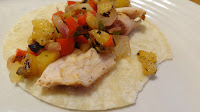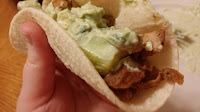I generally prefer to make freezer meals that require little work on the day of to serve. I find they're more likely to be used this way. Plain shredded chicken requires that I do something more with it than take it out of the freezer and sticking it in the oven. It is more work to serve than many of the other freezer meals I make, but it has advantages too. Precooked chicken allows me to make a large variety of meals with less effort than having to cook everything the day of and makes for tasty and easy summer meals. I prefer lighter food during the summer and a lot of heat and eat freezer meals are heavier and more suitable for winter. Plus this allows me to take advantage of the wonderful fresh produce available during the summer to round out the chicken out into a full meal.
This idea of using a precooked chicken to create a variety of meals is by no means a new one. There are many ideas and recipes online for using rotisserie chickens from the grocery store in a similar manner. Cooking and freezing the chickens yourself does have some advantages over the rotisserie ones from the store.
- The chicken is already in your freezer, ready to pull out the night before and then use. No trip to the store needed.
- The chicken is already shredded and ready to use. Getting all the meat off the bone is a significant amount of the work required to use a whole, cooked chicken, so having that part done makes pulling dinner together that much easier.
- My smoked chickens taste better than the rotisserie chickens. Use your favorite method of cooking a whole chicken and you will also have chicken you prefer instead of the rotisserie chickens, which can get a bit dry while sitting in the warmer waiting for someone to buy them.
Cooking, freezing and reheating chicken can easily result in something that is tough, dry and unpleasant, but you can have delicious, juicy chicken with the following tips.
- Properly cook your chicken, but don't overcook it. Get a meat thermometer. Chicken needs to be cooked to 165 degrees to be safe to eat. Make sure you reach that. You should never under cook meat. However, don't let it go past 165. Continued cooking after the chicken is done will make it tough, so use a meat thermometer, check the chicken regularly and take it off the heat as soon as it's done.
- I cook my chickens in this smoker. If you are considering purchasing a smoker, I highly recommend this one. It's reasonably priced and super easy and low maintenance to use. If you're not in the market for a smoker but have a gas grill, this article gives excellent instructions about how to use your grill as a smoker. I used those instructions with great success to smoke pork before I got my smoker. Using a grill is a process though and requires a lot of babysitting. That website also has instructions about how to smoke using a charcoal grill and is generally a great resource about smoking. If you don't want to smoke your chickens, then roasting them works too. Use your favorite recipe.
- Season the chicken well. I find that seasoning the chicken on top of the skin results in all of the flavor staying on the skin, which I then remove, but you do want to keep the skin on to protect and add moisture to the chicken. I make slits in the skin on the breast, thigh and drumstick, then I pull the skin gently away without breaking or removing it. Rub the meat under the skin with kosher salt and then whatever seasoning you like. Rubbing the meat with salt helps it retain moisture and results in juicier chicken. You can use whatever seasonings suit your fancy. I have BBQ rubs people have given me as gifts that I am working my way through. Just salt and pepper is fine too.
- Package the chicken well for freezing. Unfortunately precooked chicken is prone to freezer burn, which makes it dry and unpleasant. This is where my food vacuum sealer really earns its keep. If this is something you end up doing regularly, then I recommend getting one. If you're not ready for vacuum sealer, then put the shredded chicken in a zip top freezer bag and remove as much air as you can. Divide the shredded chicken into dinner-sized portions for your family. I just eyeballed this, and weighed some of them after the fact. We use about 6 oz of cooked chicken for dinner for two adults and two small children.
- Thaw the chicken in the refrigerator overnight. Thawing the chicken in the microwave increases the chance that it will dry out. In a pinch I have thawed it in the microwave on very low power. The fridge is better though.
- Spread the chicken out and cover. Microwaves do not penetrate very deep into food, so if you put you chicken in the microwave in a big pile, the chicken on the outside will overcook while waiting for the chicken in the center to heat. I spread my chicken out on a plate or in a microwave-safe pan. I make a ring with it around the outside edge and leave the center empty. Cover with plastic wrap or lid.
- Reheat the chicken gently. I'm guessing most people have had leftover chicken or turkey that while delicious initially was dry and chewy after being reheated. Reheating the chicken gently and being careful not to overheat it it will avoid this. I reheat my chicken in my microwave at 70% power in two minute bursts until hot. Microwaves vary, so you will need to experiment with your microwave to find the best way to reheat your chicken, but short bursts at a lower power will work best regardless of the microwave. I usually recommend temping food to make sure it has reached a safe temperature. However shredded chicken would be difficult to temp. Instead I heat the chicken until it is just steaming.
 |
| Ready to go in the microwave. |
Ways to use your chicken (I'll add more as I come up with them.)
BBQ Chicken with baked sweet potato and veggies - This is a regular because it is super fast and easy, and because I love sweet potatoes. Reheat the chicken in the microwave as mentioned in point 7 above. Top the chicken with barbecue sauce. Serve with a sweet potato baked in the microwave and sauteed vegetables (we generally use asparagus or green beans) or a salad. Or we have grilled corn on the cob in place of the sweet potato.
Chicken Salad Toasts - These are also very easy and don't even require reheating the chicken. I double the recipe and use 6 oz of precooked chicken in place of the two chicken breasts. I also use a store bought horseradish sauce in place the of horseradish creme fraiche and eliminate the fresh herbs.
Chicken Tacos with Pineapple Salsa - This is a good example of a pretty involved meal that is made simpler by having the chicken already cooked. It takes some effort to make this salsa, but the fact that you don't have to prepare chicken on top of that makes this easier to have on a weeknight. You could even skip grilling the salsa ingredients to make this easier still. These are very tasty. Heat the chicken in the microwave and serve it along with the salsa in warm corn tortillas
Chicken Noodle Bowls with Peanut Sauce -This is a popular one with our family and we have it frequently with guests.
Chinese Chicken Salad - Topping a salad with your precooked chicken is a pretty obvious way to use it. This salad is delicious and refreshing.
Chinese Chicken Salad - Topping a salad with your precooked chicken is a pretty obvious way to use it. This salad is delicious and refreshing.
Creamy Chicken and Spinach Tacos - A simplified version of a dish I used to make regularly.









No comments:
Post a Comment